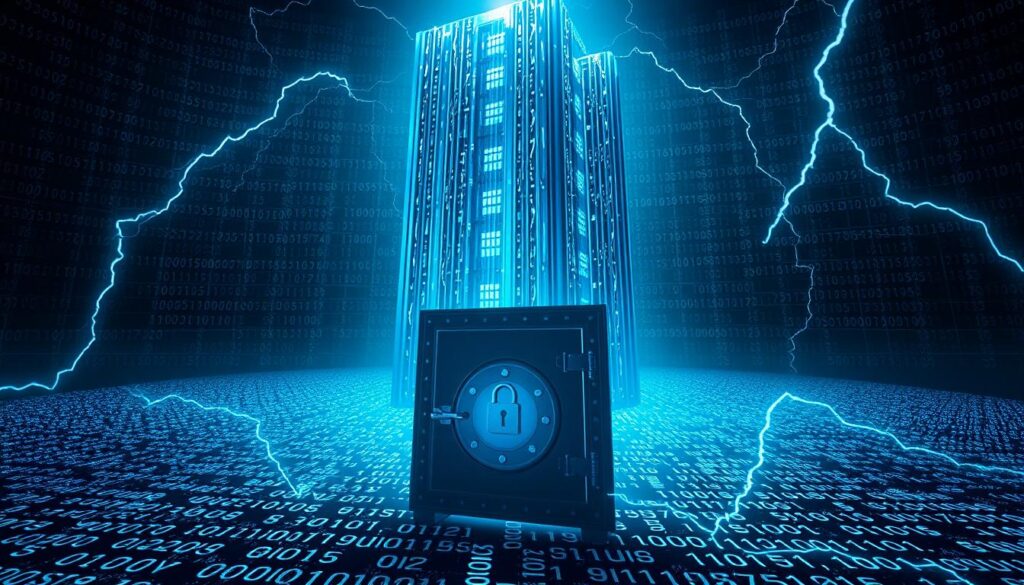
Modern computers rely on complex encryption to protect sensitive data. But emerging technology could disrupt this foundation. Recent breakthroughs in quantum computing suggest a seismic shift in processing power—one that challenges existing security measures.
Experts warn that current cryptography methods may soon become obsolete. Algorithms like RSA, which secure online transactions, could be vulnerable. The Global Risk Institute estimates a 5-14% chance of RSA-2048 being broken within five years.
Nations like China are investing heavily in this space, accelerating the timeline. For businesses and governments, the stakes are high. Proactive adaptation is no longer optional—it’s critical for safeguarding digital infrastructure.
Key Takeaways
- Quantum computing threatens widely used encryption methods.
- RSA-2048 could be compromised within the next five years.
- Global investments are speeding up quantum advancements.
- Data security requires immediate strategic planning.
- Post-quantum solutions are already in development.
What Is Quantum Supremacy? Defining the Milestone
In 2019, a tiny chip sparked a global debate about computational limits. Google’s Sycamore processor, with 53 qubits, solved a task in 200 seconds—a job classical computers would take 10,000 years to complete. This marked the first claimed achievement of quantum supremacy, where a quantum machine outperforms traditional systems in specific tasks.

Google’s 2019 Breakthrough and Its Implications
Researchers celebrated Sycamore’s random circuit sampling feat. Yet, IBM countered that classical supercomputers could solve it faster with optimized algorithms. The debate highlighted a key distinction: theoretical advantage versus real-world utility. John Preskill’s 2018 work underscored the challenge—qubit stability must improve from today’s 1–10% error rates to under 0.01% for practical use.
Quantum vs. Classical Computing: Key Differences
Unlike classical computers using binary bits (0 or 1), qubits leverage superposition, existing in multiple states simultaneously. Think of it as Formula 1 racing versus commuting: quantum excels in specialized tasks but isn’t replacing laptops yet. China’s photonic 72-qubit “Origin Wukong” system, optimized for AI, contrasts with Google’s superconducting approach.
- Speed: Quantum solves certain problems exponentially faster.
- Error Rates: Current systems need 100x improvement.
- Design: Photonic (China) vs. superconducting (Google) methods.
NIST defines a “cryptographically relevant quantum computer” as one stable enough to crack RSA-2048. We’re not there yet—but the race is accelerating.
The Quantum Threat to Encryption: Why RSA Could Fall
Encryption methods that secure our digital lives may soon be obsolete. Quantum computers threaten to dismantle systems like RSA, which protect everything from bank transactions to medical records. The Global Risk Institute warns there’s a 34% chance RSA-2048 breaks within a decade.
How Shor’s Algorithm Exploits Asymmetric Encryption
Shor’s algorithm turns prime factorization—a task that would take classical machines billions of years—into a solvable problem. A 256-bit key could be cracked in days. China’s 2025 photonic chip aims to make this a reality.

Symmetric Encryption’s Resilience (and Limits)
AES-256, a symmetric standard, fares better but isn’t immune. Grover’s algorithm reduces its security margin, though it’d still take 2.5×10^25 years to brute-force. Hybrid models combining AES-256 with post-quantum algorithms like ML-KEM are gaining traction.
| Encryption Type | Classical Crack Time | Quantum Crack Time |
|---|---|---|
| RSA-2048 | 6.5×10^11 years | Hours–days (with Shor’s) |
| AES-256 | 2^128 operations | √N speedup (Grover’s) |
The “Harvest Now, Decrypt Later” Risk
Hackers are already stealing encrypted data, betting on future quantum decryption. Healthcare records, with 30-year sensitivity windows, are prime targets. The Equifax breach data, if stored, could be unlocked post-Q-day.
- SWIFT: Banking networks rely on TLS, vulnerable to quantum attacks.
- Bitcoin: $1T market at risk if private keys are exposed.
- IoT: Weak encryption backdoors could collapse smart infrastructure.
The NSA’s Commercial National Security Algorithm Suite 2.0 outlines defenses. Proactive upgrades are no longer optional—they’re survival tactics.
Historical Precedents: Lessons from Cryptographic Failures
History shows that cryptographic failures reshape global security landscapes. The past century’s breaches—from wartime codebreaking to modern data leaks—reveal patterns we can’t ignore. Today’s race for quantum resilience mirrors history’s urgent scrambles to patch shattered systems.

WWII’s Enigma and the Cost of Broken Codes
Allied forces cracked Germany’s Enigma machine using Colossus, the first programmable computer. UK estimates suggest this shortened WWII by 2–4 years. The lesson? Overconfidence in “unbreakable” systems invites catastrophe.
Modern parallels abound. The 2023 LastPass breach exposed 25 million vaults to future decryption—a *harvest now* tactic. Like Enigma’s operators, many businesses still underestimate evolving threats.
Modern Parallels in Quantum Vulnerabilities
Encryption lifespans are collapsing. DES lasted 20 years; RSA may fall in under a decade post-quantum. The SolarWinds hack proved attackers will stockpile data for later decryption. GDPR’s Article 32 now mandates “state-of-the-art” protections, but compliance lags.
| Era | Failure | Impact | Response Cost |
|---|---|---|---|
| 1940s | Enigma | War shortened | £100M (adjusted) |
| 2000s | DES Retirement | Banking upgrades | $500M+ |
| 2020s | Quantum Migration | Global infrastructure | $3T (projected) |
GCHQ’s director warns: “Quantum is the new cryptographic Iron Curtain.” With DHS’s roadmap guiding upgrades, proactive adaptation separates survivors from casualties.
The Global Race for Quantum Dominance
Nations are pouring billions into a technological arms race with no finish line. China’s $15B investment dwarfs Western efforts, targeting a 2025 launch for its NGCC cryptographic standard. Meanwhile, the US National Quantum Initiative allocates $1.2B through 2028—a fraction of Beijing’s budget.

China’s Strategic Leap Forward
Huawei plans a 2026 quantum cloud service, leveraging photonic computers. Their approach contrasts with the EU’s €1B Quantum Flagship, focused on error correction. Lockheed Martin’s $47M F-35 data link upgrades reveal military urgency.
“By 2030, quantum computing will disrupt $125B in annual value across finance and pharma.”
Economic and Military High Stakes
JPMorgan already tests quantum Monte Carlo models for trading. Hypersonic missiles with quantum-guided systems could render current defenses obsolete. The Five Eyes alliance monitors submarine cables for harvest now attacks.
| Region | Investment | Key Project |
|---|---|---|
| China | $15B | NGCC Standard (2025) |
| USA | $1.2B | National Quantum Initiative |
| EU | €1B | Quantum Flagship |
Pharmaceutical firms like Pfizer use quantum simulation to slash R&D years. Yet, vulnerabilities persist—SWIFT’s alternative, CIPS, lacks quantum-resistant protocols. The Quantum Industry Coalition now restricts tech transfers to safeguard capabilities.
Post-Quantum Cryptography: A Path Forward
The clock is ticking for organizations relying on outdated encryption methods. NIST’s recent algorithm selections mark a turning point in security evolution. These new standards aim to protect sensitive data from future quantum attacks.
NIST’s ML-KEM and HQC Algorithms
Lattice-based cryptography uses complex geometric structures to secure information. ML-KEM, NIST’s primary choice, generates 1.5KB keys—smaller than RSA’s 2KB. HQC serves as a backup, targeting 2025 standardization.
IBM’s quantum-safe tape storage prototype demonstrates real-world applications. Cloudflare’s 2024 tests show post-quantum TLS reduces latency by just 12%. The NSA’s Suite B migration will phase out vulnerable systems by 2026.
| Algorithm | Key Size | Adoption Timeline |
|---|---|---|
| ML-KEM | 1.5KB | 2024-2026 |
| HQC | 2.1KB | 2025+ |
| RSA-2048 | 2KB | Deprecation by 2030 |
Implementing Quantum-Safe Keys Today
ProtonMail’s PQ3 rollout proves email encryption can evolve. AWS KMS now offers hybrid policies combining AES-256 with ML-KEM. However, legacy systems like COBOL face upgrade hurdles.
PCI DSS 4.0 requires quantum readiness audits for payment processors. X.509 certificates need redesigns to accommodate new algorithms. As NIST’s Dustin Moody warns: “Five years is the maximum safe migration window.”
“Hybrid approaches let enterprises bridge today’s security with tomorrow’s threats.”
- Financial sector: SWIFT testing ML-KEM for cross-border payments
- Healthcare: HIPAA updates mandate PQC for patient records
- Government: FedRAMP High requires quantum-resistant solutions by 2025
Ethical and Geopolitical Challenges Ahead
Global tensions rise as quantum technology redefines security boundaries. The EU’s 2024 Quantum Act restricts exports of critical components, while China accelerates its satellite communications network. This divide creates ethical dilemmas for researchers and policymakers alike.
Data Privacy in a Post-Quantum World
China’s 2025 quantum satellite expansion could intercept encrypted data globally. The EU counters with Article 45 mandates requiring quantum-resistant infrastructure by 2027. Healthcare systems face particular risks—patient records remain vulnerable for decades.
New deepfake threats emerge from quantum-powered AI. The IEEE proposes ethics certification to prevent misuse. As UN delegates debate governance frameworks, corporate espionage cases like Alibaba vs Google highlight talent poaching risks.
Balancing Innovation with Global Security
DARPA’s 2026 quantum sensor jammer prototypes reveal military applications. The Wassenaar Arrangement struggles to update controls on dual-use technology. CFIUS now blocks foreign investments in 72% of US quantum startups.
Central bank digital currencies face unique risks. A quantum attack could collapse financial systems overnight. Meanwhile, developing nations risk being left behind—only 3 G20 countries fund quantum education programs.
| Region | Strategy | Investment Priority |
|---|---|---|
| EU | Export Controls | Civilian Applications |
| China | Satellite Network | Military Dominance |
| USA | Talent Retention | Private Sector R&D |
The future demands international cooperation. Without shared standards, quantum could fragment the digital world into incompatible security blocs. Proactive policy-making will determine whether this technology unites or divides nations.
Conclusion: Preparing for the Quantum Era
Organizations face a tight seven-year window to future-proof their security infrastructure. Microsoft’s roadmap targets 2027 for full quantum-resistant systems—a deadline many should match or beat.
Start with a three-phase plan: audit current algorithms, deploy hybrid solutions, then transition to post-quantum standards. The NSA’s Rob Joyce puts it bluntly: “Encryption agility equals survival.” Waiting for NIST finalization risks leaving information exposed.
Boardrooms must treat quantum literacy as urgent as cybersecurity basics. CISOs need tailored risk assessments now, not in 2029 when breaches become irreversible.
The future demands alliances. A US-EU partnership could counter emerging techno-authoritarian threats while accelerating safe computing standards globally.
